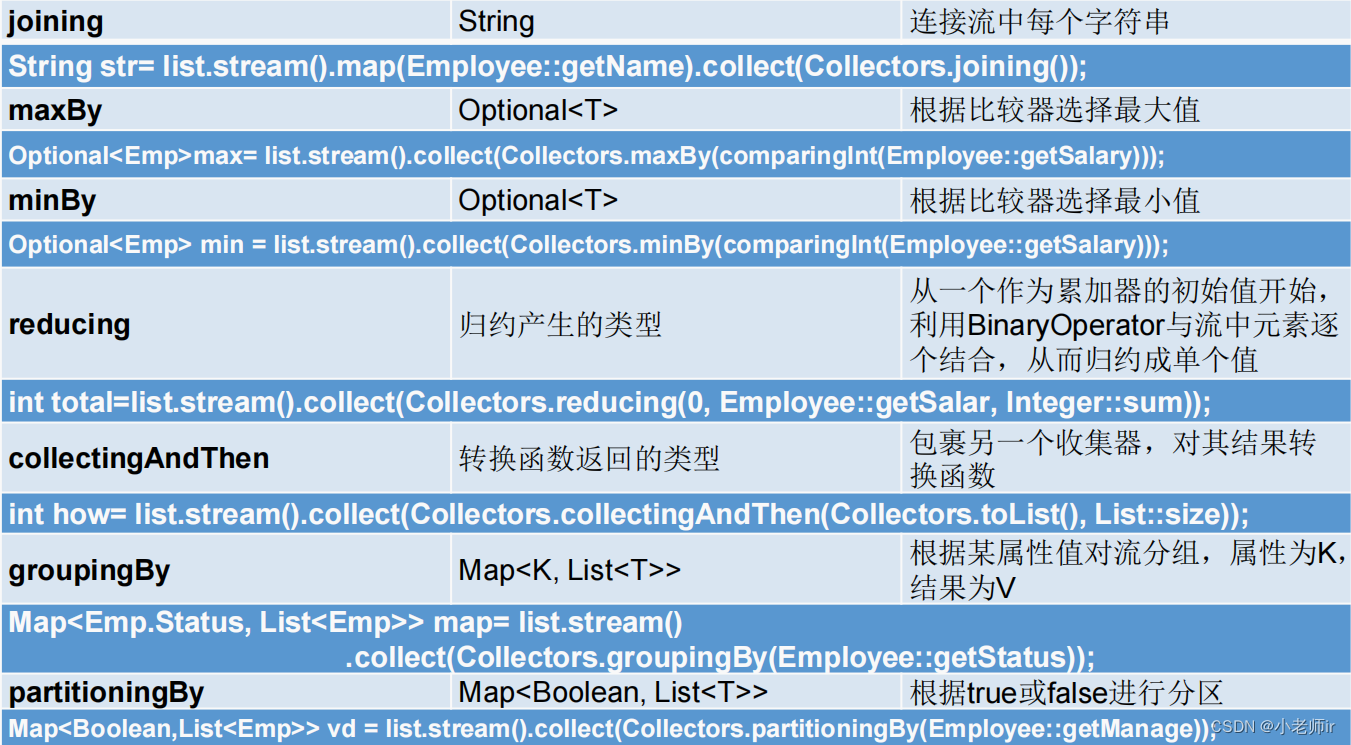Java8新特性:StreamAPI
前言
本博主将用CSDN记录软件开发求学之路上亲身所得与所学的心得与知识,有兴趣的小伙伴可以关注博主!
也许一个人独行,可以走的很快,但是一群人结伴而行,才能走的更远!让我们在成长的道路上互相学习,欢迎关注!
一、Stream API说明
- Stream API ( java.util.stream) 把真正的函数式编程风格引入到Java中。这是目前为止对Java类库最好的补充,因为Stream API可以极大提供Java程 序员的生产力,让程序员写出高效率、干净、简洁的代码。
- Stream 是 Java8 中处理集合的关键抽象概念,它可以指定你希望对集合进行的操作,可以执行非常复杂的查找、过滤和映射数据等操作。
使用 Stream API 对集合数据进行操作,就类似于使用 SQL 执行的数据库查询。也可以使用 Stream API来并行执行操作。简言之,Stream API 提供了一种高效且易于使用的处理数据的方式。
二、为什么要使用Stream API?
- 实际开发中,项目中多数数据源都来自于Mysql,Oracle等。但现在数据源可以更多了,有MongDB,Radis等,而这些NoSQL的数据就需要Java层面去处理。
- Stream 和 Collection 集合的区别:Collection 是一种静态的内存数据结构,而 Stream 是有关计算的。前者是主要面向内存,存储在内存中,后者主要是面向 CPU,通过 CPU 实现计算。
三、什么是 Stream?
是数据渠道,用于操作数据源(集合、数组等)所生成的元素序列。
“集合讲的是数据,Stream讲的是计算!”
注意:
- Stream关注的是对数据的运算,与
CPU打交道,集合关注的是数据的存储,与内存打交道。- Stream 自己不会存储元素。
- Stream 不会改变源对象。相反,他们会返回一个持有结果的新Stream。
- Stream 操作是延迟执行的。这意味着他们会等到需要结果的时候才执行
四、Stream 操作的三个步骤
1、创建 Stream
一个数据源(如:集合、数组),获取一个流。
2、中间操作
一个中间操作链,对数据源的数据进行处理。
3、终止操作(终端操作)
一旦执行终止操作,就执行中间操作链,并产生结果,之后,不会再被使用。

⭕ 注意:
- 一个中间操作链,对数据源的数据进行处理
- 一旦执行终止操作,就执行中间操作链,并产生结果。之后,不会再被使用
五、创建Stream实例
1、创建 Stream方式一:通过集合
Java8 中的 Collection 接口被扩展,提供了两个获取流的方法:
方法描述
default Stream<E> stream()
返回一个顺序流
default Stream<E> parallelStream()
返回一个并行流
代码演示:
//创建 Stream方式一:通过集合@Testpublicvoidtest1(){List<Employee> employees =EmployeeData.getEmployees();// default Stream<E> stream() : 返回一个顺序流Stream<Employee> stream = employees.stream();// default Stream<E> parallelStream() : 返回一个并行流Stream<Employee> parallelStream = employees.parallelStream();}
2、创建 Stream方式二:通过数组
Java8中的
Arrays的静态方法
stream()可以获取数组流:
方法描述
static <T> Stream<T> stream(T[] array)
返回一个流
public static IntStream stream(int[] array)
返回一个 int 型流
public static LongStream stream(long[] array)
返回一个 long 型流
public static DoubleStream stream(double[] array)
返回一个 double 型流
代码演示:
//创建 Stream方式二:通过数组@Testpublicvoidtest2(){int[] arr =newint[]{1,2,3,4,5,6};//调用Arrays类的static <T> Stream<T> stream(T[] array): 返回一个流IntStream stream =Arrays.stream(arr);Employee e1 =newEmployee(1001,"Tom");Employee e2 =newEmployee(1002,"Jerry");Employee[] arr1 =newEmployee[]{e1,e2};Stream<Employee> stream1 =Arrays.stream(arr1);}
3、创建 Stream方式三:通过Stream的of()
可以调用
Stream类静态方法
of(), 通过显示值创建一个流。它可以接收任意数量的参数。
方法描述
public static<T> Stream<T> of(T... values)
返回一个流
代码演示:
//创建 Stream方式三:通过Stream的of()@Testpublicvoidtest3(){Stream<Integer> stream =Stream.of(1,2,3,4,5,6);}
4、创建 Stream方式四:创建无限流
可以使用静态方法
Stream.iterate()和
Stream.generate(), 创建无限流。
方法描述
public static<T> Stream<T> iterate(final T seed, final UnaryOperator<T> f)
迭代
public static<T> Stream<T> generate(Supplier<T> s)
生成
代码演示:
//创建 Stream方式四:创建无限流@Testpublicvoidtest4(){// 迭代// public static<T> Stream<T> iterate(final T seed, final UnaryOperator<T> f)//遍历前10个偶数Stream.iterate(0, t -> t +2).limit(10).forEach(System.out::println);// 生成// public static<T> Stream<T> generate(Supplier<T> s)Stream.generate(Math::random).limit(10).forEach(System.out::println);}
六、Stream 的中间操作
多个中间操作可以连接起来形成一个流水线,除非流水线上触发终止 操作,否则中间操作不会执行任何的处理!而在终止操作时一次性全
部处理,称为“惰性求值”。
1、筛选与切片
方 法描 述
filter(Predicate p)
接收 Lambda, 从流中排除某些元素
distinct()
筛选,通过流所生成元素的 hashCode() 和 equals() 去除重复元素
limit(long maxSize)
截断流,使其元素不超过给定数量
skip(long n)
跳过元素,返回一个扔掉了前 n个元素的流。若流中元素不足 n个,则返回一个空流。与 limit(n) 互补
代码演示:
//1-筛选与切片@Testpublicvoidtest1(){List<Employee> list =EmployeeData.getEmployees();// filter(Predicate p)——接收 Lambda , 从流中排除某些元素。Stream<Employee> stream = list.stream();//练习:查询员工表中薪资大于7000的员工信息
stream.filter(e -> e.getSalary()>7000).forEach(System.out::println);System.out.println();// limit(n)——截断流,使其元素不超过给定数量。
list.stream().limit(3).forEach(System.out::println);System.out.println();// skip(n) —— 跳过元素,返回一个扔掉了前 n 个元素的流。若流中元素不足 n 个,则返回一个空流。与 limit(n) 互补
list.stream().skip(3).forEach(System.out::println);System.out.println();// distinct()——筛选,通过流所生成元素的 hashCode() 和 equals() 去除重复元素
list.add(newEmployee(1010,"刘强东",40,8000));
list.add(newEmployee(1010,"刘强东",41,8000));
list.add(newEmployee(1010,"刘强东",40,8000));
list.add(newEmployee(1010,"刘强东",40,8000));
list.add(newEmployee(1010,"刘强东",40,8000));// System.out.println(list);
list.stream().distinct().forEach(System.out::println);}
2、映 射
方法描述
map(Function f)
接收一个函数作为参数,该函数会被应用到每个元素上,并将其映射成一个新的元素。
mapToDouble(ToDoubleFunction f)
接收一个函数作为参数,该函数会被应用到每个元素上,产生一个新的
DoubleStream
。
mapToInt(ToIntFunction f)
接收一个函数作为参数,该函数会被应用到每个元素上,产生一个新的
IntStream
。
mapToLong(ToLongFunction f)
接收一个函数作为参数,该函数会被应用到每个元素上,产生一个新的
LongStream
。
flatMap(Function f)
接收一个函数作为参数,将流中的每个值都换成另一个流,然后把所有流连接成一个流
代码演示:
//映射@Testpublicvoidtest2(){// map(Function f)——接收一个函数作为参数,将元素转换成其他形式或提取信息,该函数会被应用到每个元素上,并将其映射成一个新的元素。List<String> list =Arrays.asList("aa","bb","cc","dd");
list.stream().map(str -> str.toUpperCase()).forEach(System.out::println);// 练习1:获取员工姓名长度大于3的员工的姓名。List<Employee> employees =EmployeeData.getEmployees();Stream<String> namesStream = employees.stream().map(Employee::getName);
namesStream.filter(name -> name.length()>3).forEach(System.out::println);System.out.println();//练习2:Stream<Stream<Character>> streamStream = list.stream().map(StreamAPITest1::fromStringToStream);
streamStream.forEach(s ->{
s.forEach(System.out::println);});System.out.println();// flatMap(Function f)——接收一个函数作为参数,将流中的每个值都换成另一个流,然后把所有流连接成一个流。Stream<Character> characterStream = list.stream().flatMap(StreamAPITest1::fromStringToStream);
characterStream.forEach(System.out::println);}//将字符串中的多个字符构成的集合转换为对应的Stream的实例publicstaticStream<Character>fromStringToStream(String str){//aaArrayList<Character> list =newArrayList<>();for(Character c : str.toCharArray()){
list.add(c);}return list.stream();}@Testpublicvoidtest3(){ArrayList list1 =newArrayList();
list1.add(1);
list1.add(2);
list1.add(3);ArrayList list2 =newArrayList();
list2.add(4);
list2.add(5);
list2.add(6);// list1.add(list2);
list1.addAll(list2);System.out.println(list1);}
3、排序
方法描述
sorted()
产生一个新流,其中按自然顺序排序
sorted(Comparator com)
产生一个新流,其中按比较器顺序排序
代码演示:
//3-排序@Testpublicvoidtest4(){// sorted()——自然排序List<Integer> list =Arrays.asList(12,43,65,34,87,0,-98,7);
list.stream().sorted().forEach(System.out::println);//抛异常,原因:Employee没有实现Comparable接口// List<Employee> employees = EmployeeData.getEmployees();// employees.stream().sorted().forEach(System.out::println);// sorted(Comparator com)——定制排序List<Employee> employees =EmployeeData.getEmployees();
employees.stream().sorted((e1,e2)->{int ageValue =Integer.compare(e1.getAge(),e2.getAge());if(ageValue !=0){return ageValue;}else{return-Double.compare(e1.getSalary(),e2.getSalary());}}).forEach(System.out::println);}
七、Stream 的终止操作
- 终端操作会从流的流水线生成结果。其结果可以是任何不是流的值,例 如:List、Integer,甚至是 void 。
- 流进行了终止操作后,不能再次使用。
1、匹配与查找
方法描述
allMatch(Predicate p)
检查是否匹配所有元素
anyMatch(Predicate p)
检查是否至少匹配一个元素
noneMatch(Predicate p)
检查是否没有匹配所有元素
findFirst()
返回第一个元素
findAny()
返回当前流中的任意元素
count()
返回流中元素总数
max(Comparator c)
返回流中最大值
min(Comparator c)
返回流中最小值
forEach(Consumer c)
内部迭代(使用
Collection
接口需要用户去做迭代,称为外部迭代。相反,
Stream API
使用内部迭代——它帮你把迭代做了)
代码演示:
//1-匹配与查找@Testpublicvoidtest1(){List<Employee> employees =EmployeeData.getEmployees();// allMatch(Predicate p)——检查是否匹配所有元素。// 练习:是否所有的员工的年龄都大于18boolean allMatch = employees.stream().allMatch(e -> e.getAge()>18);System.out.println(allMatch);// anyMatch(Predicate p)——检查是否至少匹配一个元素。// 练习:是否存在员工的工资大于 10000boolean anyMatch = employees.stream().anyMatch(e -> e.getSalary()>10000);System.out.println(anyMatch);// noneMatch(Predicate p)——检查是否没有匹配的元素。// 练习:是否存在员工姓“雷”boolean noneMatch = employees.stream().noneMatch(e -> e.getName().startsWith("雷"));System.out.println(noneMatch);// findFirst——返回第一个元素Optional<Employee> employee = employees.stream().findFirst();System.out.println(employee);// findAny——返回当前流中的任意元素Optional<Employee> employee1 = employees.parallelStream().findAny();System.out.println(employee1);}@Testpublicvoidtest2(){List<Employee> employees =EmployeeData.getEmployees();// count——返回流中元素的总个数long count = employees.stream().filter(e -> e.getSalary()>5000).count();System.out.println(count);// max(Comparator c)——返回流中最大值// 练习:返回最高的工资:Stream<Double> salaryStream = employees.stream().map(e -> e.getSalary());Optional<Double> maxSalary = salaryStream.max(Double::compare);System.out.println(maxSalary);// min(Comparator c)——返回流中最小值// 练习:返回最低工资的员工Optional<Employee> employee = employees.stream().min((e1, e2)->Double.compare(e1.getSalary(), e2.getSalary()));System.out.println(employee);System.out.println();// forEach(Consumer c)——内部迭代
employees.stream().forEach(System.out::println);//使用集合的遍历操作
employees.forEach(System.out::println);}
2、归约
方法描述
reduce(T iden, BinaryOperator b)
可以将流中元素反复结合起来,得到一个值。返回
T
reduce(BinaryOperator b)
可以将流中元素反复结合起来,得到一个值。返回
Optional<T>
代码演示:
//2-归约@Testpublicvoidtest3(){// reduce(T identity, BinaryOperator)——可以将流中元素反复结合起来,得到一个值。返回 T// 练习1:计算1-10的自然数的和List<Integer> list =Arrays.asList(1,2,3,4,5,6,7,8,9,10);Integer sum = list.stream().reduce(0,Integer::sum);System.out.println(sum);// reduce(BinaryOperator) ——可以将流中元素反复结合起来,得到一个值。返回 Optional<T>// 练习2:计算公司所有员工工资的总和List<Employee> employees =EmployeeData.getEmployees();Stream<Double> salaryStream = employees.stream().map(Employee::getSalary);// Optional<Double> sumMoney = salaryStream.reduce(Double::sum);Optional<Double> sumMoney = salaryStream.reduce((d1,d2)-> d1 + d2);System.out.println(sumMoney.get());}
3、收集
方 法描 述
collect(Collector c)
将流转换为其他形式。接收一个
Collector
接口的实现,用于给
Stream
中元素做汇总的方法
Collector 接口中方法的实现决定了如何对流执行收集的操作(如收集到 List、Set、Map)。
另外, Collectors 实用类提供了很多静态方法,可以方便地创建常见收集器实例,具体方法与实例如下表:


//3-收集@Testpublicvoidtest4(){// collect(Collector c)——将流转换为其他形式。接收一个 Collector接口的实现,用于给Stream中元素做汇总的方法// 练习1:查找工资大于6000的员工,结果返回为一个List或SetList<Employee> employees =EmployeeData.getEmployees();List<Employee> employeeList = employees.stream().filter(e -> e.getSalary()>6000).collect(Collectors.toList());
employeeList.forEach(System.out::println);System.out.println();Set<Employee> employeeSet = employees.stream().filter(e -> e.getSalary()>6000).collect(Collectors.toSet());
employeeSet.forEach(System.out::println);}
版权归原作者 _GGBond_ 所有, 如有侵权,请联系我们删除。